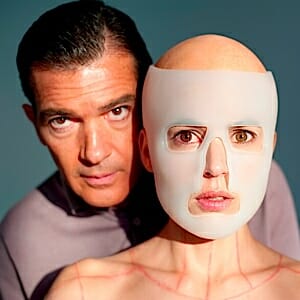
With The Skin I Live In, based on the novel Mygale by Thierry Jonquet, Pedro Almodóvar continues his career-long examination of the feminine mystique from the outside inward. In this case, that’s a good thing. The skin in question has many meanings here beyond the largest organ of the human body, though that’s certainly on ample display. In this engaging thriller, skin can refer to anything from protection, to pretension, to the last dangling thread of identity in a world that makes no sense.
Antonio Banderas plays Dr. Robert Ledgard, an accomplished and vastly wealthy plastic surgeon with a mansion in Toledo, Spain, who has its own operating room for his clients. At the beginning, we meet him in his home, along with Vera (Elena Anaya), a beautiful young woman alone in one of the mansion’s rooms, who we’re informed bears a striking resemblance to the doctor’s dead wife. With her toned physique, decked out in a beige unitard with stitchings that outline various body parts, Vera resembles a performer from Frankenstein as envisioned by Martha Graham. From the multiple security cameras pointed at her, to the copious tick marks, crowded writings, and artwork meticulously sketched on the wall, it becomes pretty clear that she’s being held captive.
It’s no big surprise that Ledgard uses her for experiments, such as to test out his controversial new artificial skin, resistant to high temperature and bug bites. But the true reason for her captivity, as well as the vague but charged relationship she shares with the doctor, is the core mystery explained through flashbacks that account for a large portion the film.
After only hearing Banderas basically parody himself in the Shrek movies for so long, it’s nice to actually see him up on the screen. Since the demands of the story require him to keep his motivations below the surface, he doesn’t have a very showy role as the mysterious surgeon, but still he does well enough with it. The ethereal Elena Anaya has to remain similarly cryptic to keep the audience guessing, but as a beguiling and striking woman with flawless skin, she certainly fits the bill. Almodóvar veteran Marisa Paredes also appears as Marilia, Dr. Ledgard’s complicit head servant, who also seems to have a deeper connection to the proceedings. Of all the performances, only hers falters slightly, veering dangerously close to camp at one point, but not enough to seriously detract.
The story is the star here, and Almodóvar services it well by keeping a good clinical distance from these characters, letting the audience peer in at them, much like the doctor does Vera. This lets the viewer make up his own mind about them, which is especially important since many of the key players have moments of questionable morality. Also to the director’s credit, at close to two hours long, the film still feels short due to the economic storytelling. There isn’t a wasted frame, and the layers of the mystery are revealed in just the right way to maintain interest.
There are shades of Hitchcock throughout, and even a touch of Fellini in the guise of an interloper in a tiger costume. At times, the symbolism speaks more for the characters than they do, but it’s never overdone; keep an eye out for a very cool yin/yang tableau near the end. And speaking of the end, there’s a refreshingly satisfying ending to the story that an American-made film would likely have copped out of. The movie may not be quite as deep as it thinks, but even if it doesn’t make you question your own sense of identity, it’s certainly a cut above.